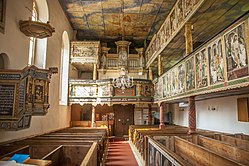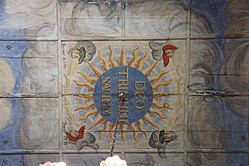Reinhardtsdorf (Reinhardtsdorf-Schöna)
|
Reinhardtsdorf
Community Reinhardt-Schöna
Coordinates: 50 ° 53 '35 " N , 14 ° 11' 35" E
|
||
|---|---|---|
| Height : | 260 m above sea level NN | |
| Residents : | 822 | |
| Incorporation : | 1st January 1973 | |
| Postal code : | 01814 | |
| Area code : | 035028 | |
|
Location of Reinhardtsdorf in Saxony |
||
Reinhardtsdorf is a district of the municipality Reinhardtsdorf-Schöna in the district of Saxon Switzerland-Eastern Ore Mountains .
geography
Reinhardtsdorf is located southeast of the Saxon capital Dresden in the south of Saxon Switzerland , but in the center of the Elbe Sandstone Mountains . It is located in the east of the Saxon Switzerland-Eastern Ore Mountains district in the Saxon Switzerland landscape protection area . The Waldhufendorf is located in the north of the Reinhardtsdorf-Schöna community. The location Reinhardtsdorf is in the valley of the Reinhardtsdorfer Bach, which flows into the Krippenbach west of the place . The Reinhardtsdorfer sandstone named after the place is extracted in a quarry on the slopes of the valley . The Wolfsberg rises immediately south of the village .
The actual Reinhardtsdorfer Waldhufenflur, which is largely used for agriculture, comprised 670 hectares. The Reinhardtsdorf district was almost threefold when the forest areas south of the town between Krippenbach, Elbhang and the federal border, in which the Zschirnsteine are located, were added to it. Reinhardtsdorf therefore also includes the Große Zschirnstein (561.74 m), the highest mountain in the German part of the Elbe Sandstone Mountains. Another table mountain in the area is the Kleine Zschirnstein (472.7 m). Most of the corridor lies on the Reinhardtsdorf-Schöna flatness . The neighboring town of Schöna borders directly to the southeast along the Mühlgrundbach in Hirschgrund.
In the extreme northeast of the corridor, Reinhardtsdorf has a share of the Elbe on a short section below the Hirschmühle , which flows here in a narrow valley to the northwest and breaks through the highest part of the Elbe Sandstone Mountains. The Schmilka district of Bad Schandau borders in the middle of the river . Reinhardtsdorf offers a view of the Schrammsteine across the valley . The corridors in the valley on the left bank of the Elbe north of Reinhardtsdorf belong to the Schandau district of Krippen , which is neighboring to the northwest.
In the west, the Krippenbach is bordered by the Papstdorf corridor , which belongs to the Gohrisch community . The southwestern neighbor of Reinhardtsdorf is Kleingießhübel , the third district of Reinhardtsdorf-Schönas. Above Kleingießhübels, the district of Cunnersdorf borders the Krippenbach to the west, which in turn belongs to Gohrisch. The southern border of the Reinhardtsdorf district is identical to the southern border of the municipality. It runs along the federal border with the Czech Republic and largely follows the Gelobtbach . The next place to the south is Maxičky (Maxdorf), a district of Děčín (Tetschen), eight kilometers away as the crow flies .
church
A Romanesque fortified church in the 11th / 12th centuries. The structure built in the 19th century no longer exists. The church from the 15th / 16th centuries Century shows itself especially in its interior in the style of the baroque . This reshaping took place between 1675 and 1689. It was also associated with an expansion of the Church. In 1675, the decorated west portal by Heinrich Weingarten, Pirna, and the roof turret over the west gable adorned with the hood, lantern and onion were built.
The four-storey altar was built between 1681 and 1684, i.e. during the baroque period. His paintings show the Lord's Supper, Jesus Christ carrying the cross and the crucifixion. On the altar is a carved sculpture showing Christ with the flag of victory. There are two galleries on one side . The paintings in the two galleries and the colored ceiling date from 1711. This year can be found in the middle of the ceiling. The inscription in the middle of the ceiling DEO TRINUNI SACRUM means “Holy to the Triune God”. The flat wooden ceiling shows the Holy Trinity above the altar and the Last Judgment in the western part . The former main altar, a winged altar in the form of a triptych , is marked in the middle part with "1521". This late Gothic carved altar now hangs on the south side of the church. In his shrine is a carved and colored group of sculptures of St. Anne herself . Reliefs of saints by Wenzel and Veit (left), Martin and Nikolaus (right) can be found on the inside of the wings of the altar. Outside, paintings show Emperor Heinrich the Holy and Saint Wolfgang .
In 1911 the baroque case of the organ was widened and an organ by Hermann Eule , Bautzen, was installed. It has two manuals and 14 stops.
- Evangelical Lutheran Church in Reinhardtsdorf
traffic
The most important street on Reinhardtsdorfer Flur is the state road 169 in the Krippengrund, which connects from Cunnersdorf to the federal road 172 at the Bad Schandau train station . District road 8744 joins it, which, under the name Hauptstrasse, opens up the village centers of Reinhardtsdorf and Schöna. Various other streets branch off from here in Reinhardtsdorf. Reinhardtsdorf is connected to the regional bus network of the Saxon Switzerland-Eastern Ore Mountains (RVSOE) .
literature
- Between Sebnitz, Hinterhermsdorf and the Zschirnsteinen (= values of the German homeland . Volume 2). 1st edition. Akademie Verlag, Berlin 1959, p. 162 ff.
- Alfred Meiche : Historical-topographical description of the Pirna administration. Dresden 1927 (ND Sebnitz 1991).
Web links
- Reinhardtsdorf in the Digital Historical Directory of Saxony
- Reinhardtsdorf on the website of the community Reinhardtsdorf-Schöna
Individual evidence
- ^ Population, households, families as well as buildings and apartments on May 9, 2011 according to parts of the municipality. (PDF; 770 KB) In: Kleinräumiges Gemeindeblatt Census 2011. State Statistical Office Saxony , accessed on October 4, 2016 .
- ^ Website of the Evangelical Lutheran parish Bad Schandau
- ↑ a b c d e f g Dietmar Möschner: Churches in Saxon-Bohemian Switzerland, published by the Saxon Switzerland Tourist Board. V., 2nd edition, Bad Schandau 2002, p. 28






